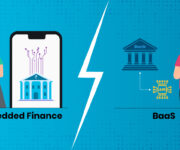Technology has advanced so dramatically over the last decade that consumers can order a ride before arriving at their destination. In addition, they can pay utility bills without leaving their homes. In today’s modern world, instant payment systems are a part of our everyday lives, but where does the money come from? The answer is embedded finance.
But what exactly is embedded finance? It is the integration of financial services with non-financial services. It simplifies financial processes and enables consumers to access whatever they need when they need it.
For example, it allows customers to purchase and obtain credit in one location rather than visiting a physical bank to apply for credit and then make the purchase. Customer-facing digital platforms use embedded finance technology to integrate financial services into their offerings.
Let us elaborate in this blog post on a few aspects of embedded finance in this blog post.
What Is the Purpose of Embedded Finance?
Earlier, users had to be directed to a financial service provider at the point of purchase. For example, when booking airline tickets, you can purchase travel insurance. This friction does not contribute to a positive customer experience.
Businesses can sometimes risk losing all of their customers. Customers benefit from a more convenient checkout experience when a travel insurance plan or a BNPL option is embedded into the travel app, not to mention the additional revenue stream for non-financial firms through payment fees.
The appeal of embedded finance will only grow as the digital payments space expands. Today, many non-financial businesses, such as e-commerce players, merchants, and small enterprises, are adopting this strategy.
What Is Embedded Finance’s Role in the Lending Industry?
Embedded lending revenues are expected to increase by US $199,924.6 million by 2029, with a CAGR of 27.5%. Embedded finance allows non-financial companies to directly provide financial products and services to their customers, including loans and credit.
- By embedding these services, lenders can provide more convenient and streamlined financial experiences for their customers. Additionally, it allows companies to offer tailored and flexible lending options, making them more attractive to customers.
- Embedded finance is particularly beneficial to the lending industry because it allows companies to reach new customer segments and improve customer retention. For example, a car manufacturer can offer financing options specifically designed for car-buying, making it easier for customers to purchase a car.
- Additionally, fintech brands are making inroads in the insurance market, developing innovative platforms, and developing contextual insurance products and services. This accelerates the growth of embedded finance in new markets. By 2032, the market may reach US$ 248.1 billion, up from $54.3 billion in 2022.
3 Key Players in the Embedded Finance Ecosystem
An Embedded Finance Infrastructure comprises three key institutions collaborating to provide users with financial solutions.
1. Digital content platforms
Non-FinTech firms or businesses that own a customer-facing digital platform, such as a mobile app, a website, or a desktop application. They can offer customised financial solutions to customers entrenched within their platform due to their deep understanding of target audience segments.
2. Financial institutions
The purpose of banks, NBFCs, and microfinance institutions is dual. First, they offer financial services and are best suited to managing regulatory compliance and credit risk. Using their network and workforce, they can also process loan requests from the embedded finance ecosystem.
3. Finance infrastructure provider
FinTech company that develops APIs and SDKs to connect financial institutions to digital platforms. SDKs (Software Development Kits) are simply used to integrate functionalities into mobile or web apps. Embedded finance offers loan lifecycle UI, alternative data underwriting engines, customer service, and more as part of its platform/app.
How Does Embedded Finance Benefit Lending Institutions?
In addition to streamlining the integration of financial services into conventional non-financial services, embedded finance has several other benefits for the lending industry:
1. Easy customer acquisition
NBFCs can reach a large and appropriate customer base by collaborating with businesses and embedding their offerings on relevant websites and apps. Financial services can also be offered through websites and apps to riskier customers, which traditional lending methods can hardly achieve.
2. Relevant data collection
In addition to financial data, financial institutions have access to other data, such as shopping preferences and frequency of usage of specific services such as cab-hailing, etc. Therefore, they can curate specific financial products and cross-sell other offerings accordingly.
3. Simplified consumer management
With the companies running the websites and apps dealing with customers, the financial institutions’ and businesses’ responsibility for user lifecycle management is divided, easing the burden on the financial institutions to cater to queries, customer service, and so on.
4 Future Trends in Embedded Finance in the Lending Industry
Embedded finance in lending is expected to continue growing in the future, with several trends emerging ranging from:
1. Increased integration
Embedded finance will become even more integrated into non-financial products and services as financial services become a core component. This will make accessing financial services even more convenient for customers and increase the reach of digital lending platforms.
2. Increased use of AI and machine learning (ML)
Using AI and machine learning in digital lending platforms is expected to improve customer experience and make more informed lending decisions. This will allow for a more personalised loan experience for customers.
3. Increased use of open banking
Open banking lets customers share their financial data with third parties through embedded finance in digital lending. By utilising this data, digital lending platforms can make better lending decisions about their customers.
4. Increased use of mobile-based lending
Embedded finance in digital lending is expected to increasingly leverage mobile-based lending, which allows customers to access loans via mobile apps as mobile usage increases. By making it easier for customers to apply for loans, digital lending platforms can reach more customers.
Summing It Up
Embedded finance has cut through much red tape, and business owners are looking to integrate payments and financial services into their software seamlessly. Increasing access to these services is inevitable.
For customers, embedded finance simplifies access to services, and for businesses, it increases customer touchpoints, cross-selling opportunities, and the customer experience.
With lenders focusing on customers and monetising through fees and subscriptions, the finance ecosystem has more players than ever with their markets, which is why fintech companies continue to innovate their solutions every day.
Finezza is one such tool. It is the ultimate solution for lending lifecycle management and credit evaluation. Our suite of lending management applications streamlines the lending process, making it easy for financial institutions to manage their loans and evaluate creditworthiness.
With Finezza, you can automate loan origination, underwriting, and servicing while gaining access to advanced credit evaluation tools. This means faster loan approvals, better risk management, and improved customer experience.
Talk to us to upgrade your lending process with Finezza today!




Leave a Reply